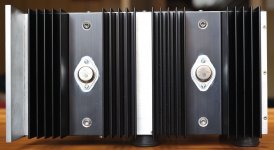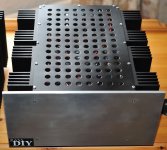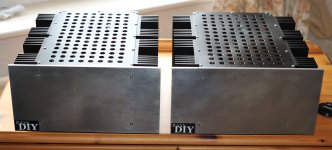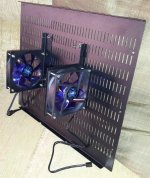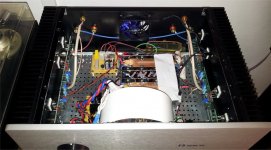Oh, Oh - Me thinks I see a Dynaco PAT-4A.
I've been dragging mine along for years hoping to upgrade at some point. Most likely on a different thread or PM, but I'm curious about your use/intentions.
We want more pictures once you get a project started. 😉
I've been dragging mine along for years hoping to upgrade at some point. Most likely on a different thread or PM, but I'm curious about your use/intentions.
We want more pictures once you get a project started. 😉
Last edited:
Oh, Oh - Me thinks I see a Dynaco PAT-4A.
I've been dragging mine along for years hoping to upgrade at some point. Most likely on a different thread or PM, but I'm curious about your use/intentions.
We want more pictures once you get a project started. 😉
Intentions? Probably to sell the 3 PAT-4s I have, along with their original wooden cases(!). So many toys, so little time, and so little space.
Don't know what my next audio project will be. I do have the makings for some large panel electrostatics, and that may be next--but first, I have two "project cars" I'm working on, and I need to finish them before I feel guilty for neglecting them.....!
Will your next project car AND Pass Amp be painted to match in Gulf livery?
More like orange. Like, Bruce McLaren's Can-Am car orange(!) 😉
A40 Monoblocks Complete.
At last the A40s are finished! The sound from these is EPIC, simply stunning. Huge soundstage, super sweet treble and pile driver bass with superb grip and control (no doubt aided by the use of a 500VA toroid with 44,000uF per channel). If anything these are a perfect lesson in how power ratings can be misleading; the power amp they replace is rated at 100 watts per channel (an Audiolab 8000P which is very nearly 26 years old) and these monoblocks just blow it into the weeds. I was wondering, when I was building them, if there would be enough power for my KEF Q7s!
I have not driven the amps to clipping because the Q7s sound like they might burst and also my ears wouldn’t stand any more volume. What is also amazing is how effortless and relaxed the sound remains at this volume. Another plus point is that the sound is every bit as good at very low volumes too. All in all I am absolutely gobsmacked by the magnitude of the improvement over my old amp (the KEFs sound amazing when driven properly with a quality signal) and I’m still using the Audiolab preamp (8000C) with the A40s, but not for long because I’ve just received a B1 buffer preamp PCB with matched JFETS from Pass Diy.
Eric, thanks for your comments after my previous post, I really enjoyed reading your website.
Regards,
Earthloop.
At last the A40s are finished! The sound from these is EPIC, simply stunning. Huge soundstage, super sweet treble and pile driver bass with superb grip and control (no doubt aided by the use of a 500VA toroid with 44,000uF per channel). If anything these are a perfect lesson in how power ratings can be misleading; the power amp they replace is rated at 100 watts per channel (an Audiolab 8000P which is very nearly 26 years old) and these monoblocks just blow it into the weeds. I was wondering, when I was building them, if there would be enough power for my KEF Q7s!
I have not driven the amps to clipping because the Q7s sound like they might burst and also my ears wouldn’t stand any more volume. What is also amazing is how effortless and relaxed the sound remains at this volume. Another plus point is that the sound is every bit as good at very low volumes too. All in all I am absolutely gobsmacked by the magnitude of the improvement over my old amp (the KEFs sound amazing when driven properly with a quality signal) and I’m still using the Audiolab preamp (8000C) with the A40s, but not for long because I’ve just received a B1 buffer preamp PCB with matched JFETS from Pass Diy.
Eric, thanks for your comments after my previous post, I really enjoyed reading your website.
Regards,
Earthloop.
Attachments
Pass DIY Addict
Joined 2000
Paid Member
Earthloop - VERY nice mono blocks! They look great and evidently they sound great as well! Congrats on a nice looking build. I've been very pleased with mine and still listen to it nearly every day. Glad to hear you found my web page of some value.
Eric
Eric
Wrong.
At the rear has no fan. Just got the grill.
On top the fan is to extract air out.😀

Has anyone noticed that fans (at least, all the ones I've seen until now) blow air in the direction of the sticker/frame? So, as seen in the pictures, that fan is blowing air into the case from the top cover.
Have you checked that?
Just out of curiosity, then why almost all elec. equip. use to mount fans sucking air out of the enclosure?A fan or pump always works more effectively "blowing" the fluid.
A fan in the bottom of a case blowing up will perform better than a fan mounted on the top sucking up.
At last the A40s are finished!
Weight per amp?
Regards zeoN_Rider
Air conditioner condenser fans are mounted on top, sucking air through the coils, as are computer CPU fans, but this may be because of existing geometry.
To me, it is alway's best as Andrew indicates, pushing air instead of sucking air. Sucking air always has the detriment of hot air cooking the fan internals too...
To me, it is alway's best as Andrew indicates, pushing air instead of sucking air. Sucking air always has the detriment of hot air cooking the fan internals too...
Air conditioner condenser fans are mounted on top, sucking air through the coils
Think moisture.
depends on what you want
1. blowing cool air directly on a small surface
2.removing hot air from a space
1. blowing cool air directly on a small surface
2.removing hot air from a space
Has anyone noticed that fans (at least, all the ones I've seen until now) blow air in the direction of the sticker/frame? So, as seen in the pictures, that fan is blowing air into the case from the top cover.
Have you checked that?
Just out of curiosity, then why almost all elec. equip. use to mount fans sucking air out of the enclosure?
We had a whole discussion of this a few posts back. The reason why fans pull air out is that it is generally more efficient for the entire enclosure whereas blowing in cools parts directly in flow path of fan. Has advantage of not sucking dust into box by maintaining positive pressure if used with filter over fan inlet.
Its not a amp but one of pass's other cool designs scaled down.....
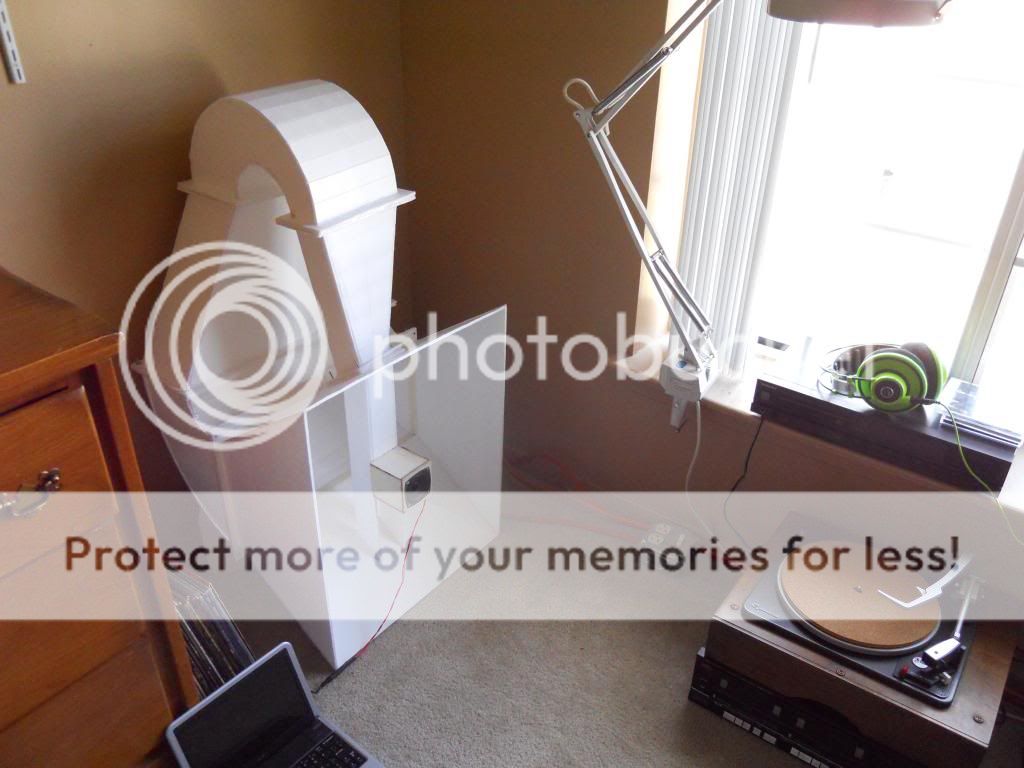
Thanks for the rockin design, just wish I could build it full size, but the space isn't their....

Thanks for the rockin design, just wish I could build it full size, but the space isn't their....
wery cool🙂 and a little more convenient for normal households🙂 the original damands a lot of Space🙂
Of the many experiences I had with fans, this is the one that gives better results.
A rear blower 80 to draw air, and two fans 92 to provide air channels to the pcbs.
Fans DBs are low, 10 and 17dBs.
One thing I discovered, if you connect a sensor F5T temps and only when it is hot it turns the fans, takes a long time to cool down.
I removed the sensor, when I turn the F5T the fans start to spin, then the temps will keep a long time with very reasonable temperatures.
A rear blower 80 to draw air, and two fans 92 to provide air channels to the pcbs.
Fans DBs are low, 10 and 17dBs.
One thing I discovered, if you connect a sensor F5T temps and only when it is hot it turns the fans, takes a long time to cool down.
I removed the sensor, when I turn the F5T the fans start to spin, then the temps will keep a long time with very reasonable temperatures.
Attachments
I think general situation in our conventional class A amp designs is option 2, right? We use to spread trannies along big heatsinks with a big area. Heat is more or less the same along the whole internal enclosure area (after a considerable amount of time needed to stabilize temps, lets say, one hour?). My point is that there are no real hotspots, my class A amps are hot anywhere, including front handles if they're installed!depends on what you want
1. blowing cool air directly on a small surface
2.removing hot air from a space
I have measured with my IR thermometer that difference betweent the hottest and the coldest spot along the whole amplifier is no more than 10º.
Using an small heatsink installed inside the enclosure for the purpose of being active refrigerated is a whole different point, so option 1 would apply.
Sorry guys, xrk971, for being late to the discussion, I didn't see there were two more pages of discussion 🙄 messy head I have....
Oh, and as a side effect, if you put a filter in a fan blowing air out, you have a permanent steady vacuum cleaner that may aid to keep your room cleaner 😀
Its not a amp but one of pass's other cool designs scaled down.....

Thanks for the rockin design, just wish I could build it full size, but the space isn't their....
What is that it looks really cool, how big is the original. I take it that is a full range driver. How does it sound.
Its not a amp but one of pass's other cool designs scaled down.....

Thanks for the rockin design, just wish I could build it full size, but the space isn't their....
Did you make this out of foam core? Very cool, I have been thinking of doing a very similar design. If it is foam core did you know that you can produce beautiful smooth bends with it by scoring the concave side to pierce the paper?
See this thread http://www.diyaudio.com/forums/full-range/223313-foam-core-board-speaker-enclosures.html
Thanks man, here's the real one, It's huge!
http://www.mh-audio.nl/Downloads/KleinHorn.pdf
the whole thing is foam board, I wanted to test it before i build one out of wood, because i had no idea how it would sound scaled down. for the bends i did score it, but i put the score mark's on the outside so that the inside was completely smooth.
The drivers were given to me by a friend and have no marks but they rock, since this pic I've added a phase plug and have been messing with a wizzer cone, not successfully yet though.
The sound, is just great, they do nothing offensive, they can't go supper low, nor really high, but the mid range is magical. I'm just curious what the real one sound like compared to my cheap copy. There also just great for movies if you add a sub. Just so spaceish sounding its crazy.
Unfortunately they're just so ugly that they're going back in the basement...
http://www.mh-audio.nl/Downloads/KleinHorn.pdf
the whole thing is foam board, I wanted to test it before i build one out of wood, because i had no idea how it would sound scaled down. for the bends i did score it, but i put the score mark's on the outside so that the inside was completely smooth.
The drivers were given to me by a friend and have no marks but they rock, since this pic I've added a phase plug and have been messing with a wizzer cone, not successfully yet though.
The sound, is just great, they do nothing offensive, they can't go supper low, nor really high, but the mid range is magical. I'm just curious what the real one sound like compared to my cheap copy. There also just great for movies if you add a sub. Just so spaceish sounding its crazy.
Unfortunately they're just so ugly that they're going back in the basement...
- Home
- Amplifiers
- Pass Labs
- Pictures of your diy Pass amplifier
